2015 NISSAN ARMADA PLATINUM TPMS
[x] Cancel search: TPMSPage 112 of 510
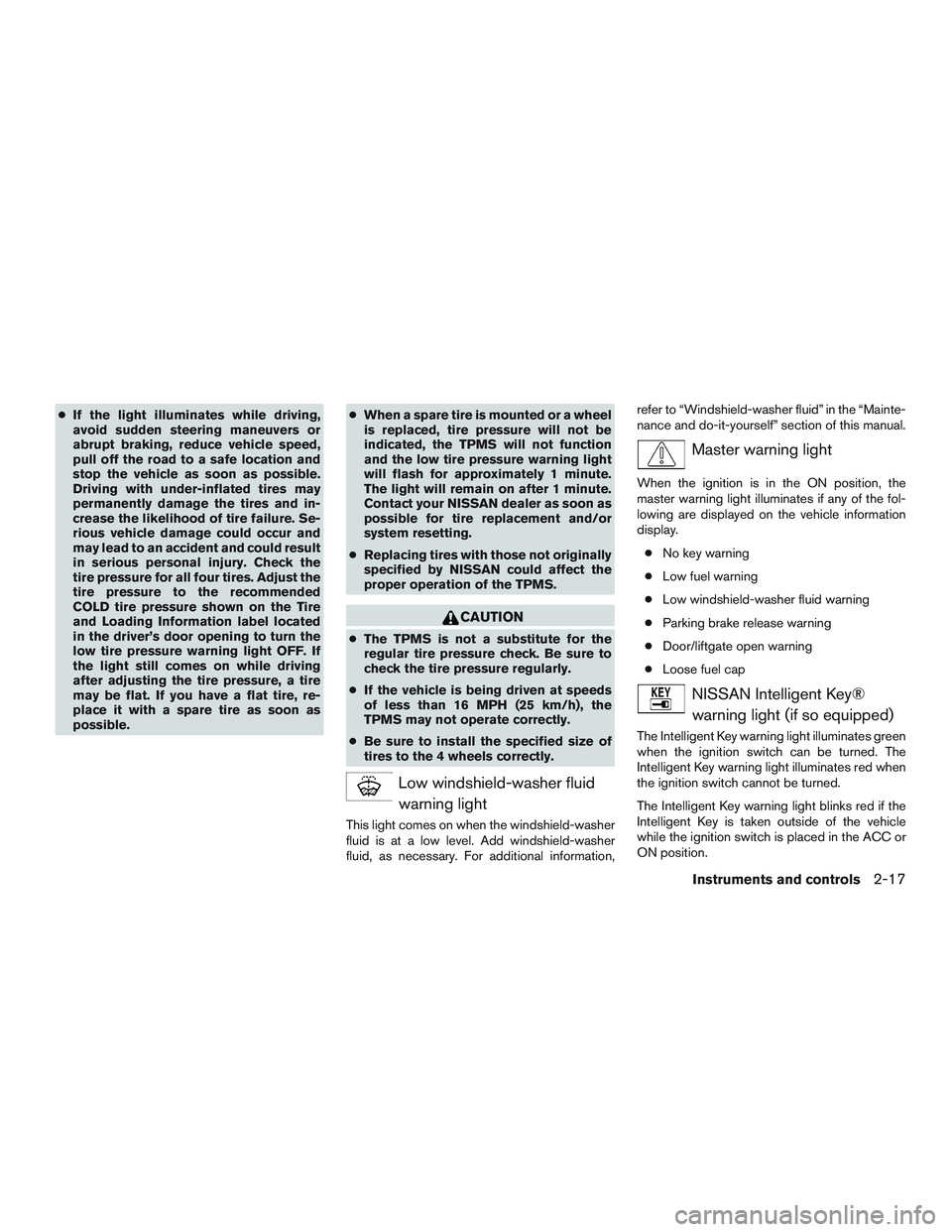
●If the light illuminates while driving,
avoid sudden steering maneuvers or
abrupt braking, reduce vehicle speed,
pull off the road to a safe location and
stop the vehicle as soon as possible.
Driving with under-inflated tires may
permanently damage the tires and in-
crease the likelihood of tire failure. Se-
rious vehicle damage could occur and
may lead to an accident and could result
in serious personal injury. Check the
tire pressure for all four tires. Adjust the
tire pressure to the recommended
COLD tire pressure shown on the Tire
and Loading Information label located
in the driver’s door opening to turn the
low tire pressure warning light OFF. If
the light still comes on while driving
after adjusting the tire pressure, a tire
may be flat. If you have a flat tire, re-
place it with a spare tire as soon as
possible. ●
When a spare tire is mounted or a wheel
is replaced, tire pressure will not be
indicated, the TPMS will not function
and the low tire pressure warning light
will flash for approximately 1 minute.
The light will remain on after 1 minute.
Contact your NISSAN dealer as soon as
possible for tire replacement and/or
system resetting.
● Replacing tires with those not originally
specified by NISSAN could affect the
proper operation of the TPMS.
Page 357 of 510
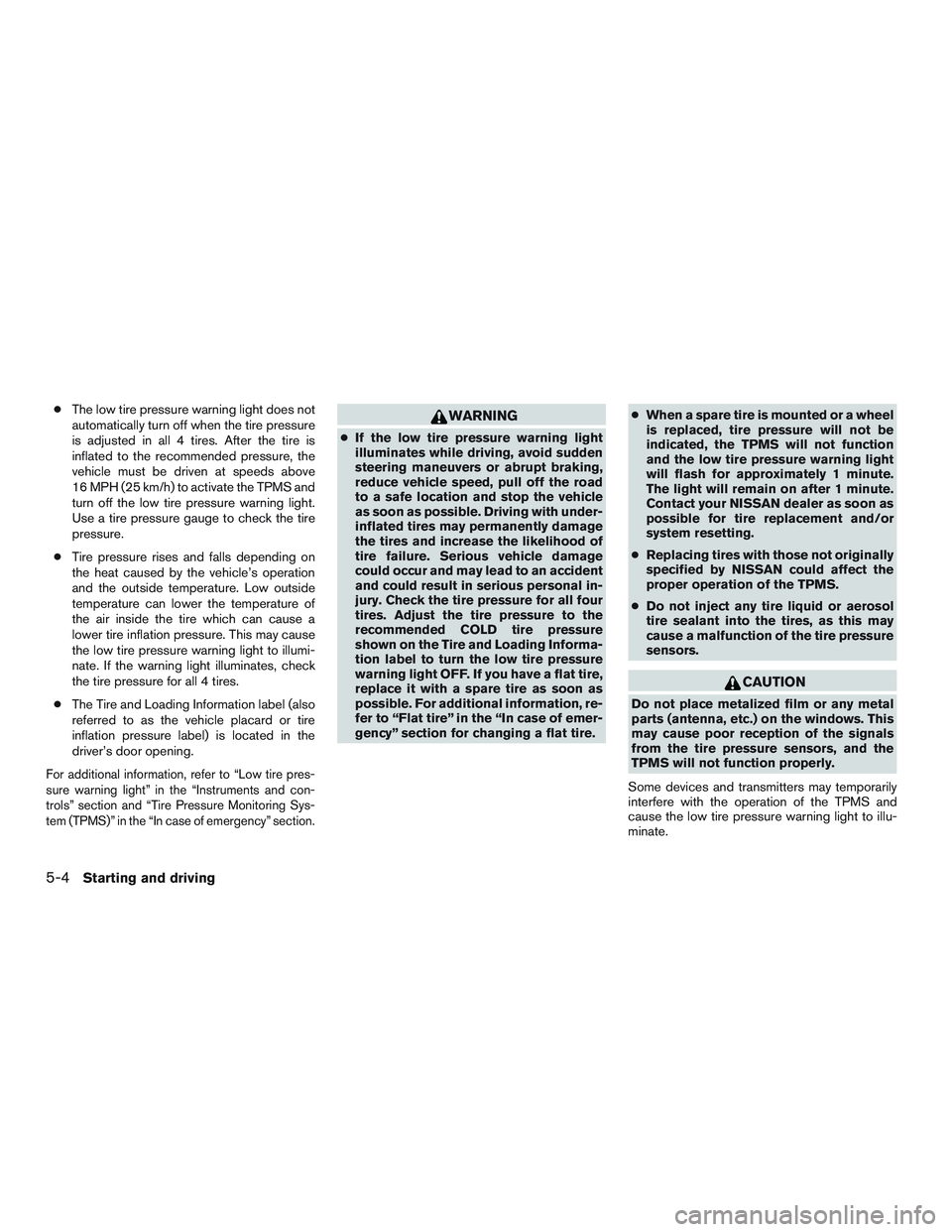
●The low tire pressure warning light does not
automatically turn off when the tire pressure
is adjusted in all 4 tires. After the tire is
inflated to the recommended pressure, the
vehicle must be driven at speeds above
16 MPH (25 km/h) to activate the TPMS and
turn off the low tire pressure warning light.
Use a tire pressure gauge to check the tire
pressure.
● Tire pressure rises and falls depending on
the heat caused by the vehicle’s operation
and the outside temperature. Low outside
temperature can lower the temperature of
the air inside the tire which can cause a
lower tire inflation pressure. This may cause
the low tire pressure warning light to illumi-
nate. If the warning light illuminates, check
the tire pressure for all 4 tires.
● The Tire and Loading Information label (also
referred to as the vehicle placard or tire
inflation pressure label) is located in the
driver’s door opening.
For additional information, refer to “Low tire pres-
sure warning light” in the “Instruments and con-
trols” section and “Tire Pressure Monitoring Sys-
tem (TPMS)” in the “In case of emergency” section.
Page 396 of 510
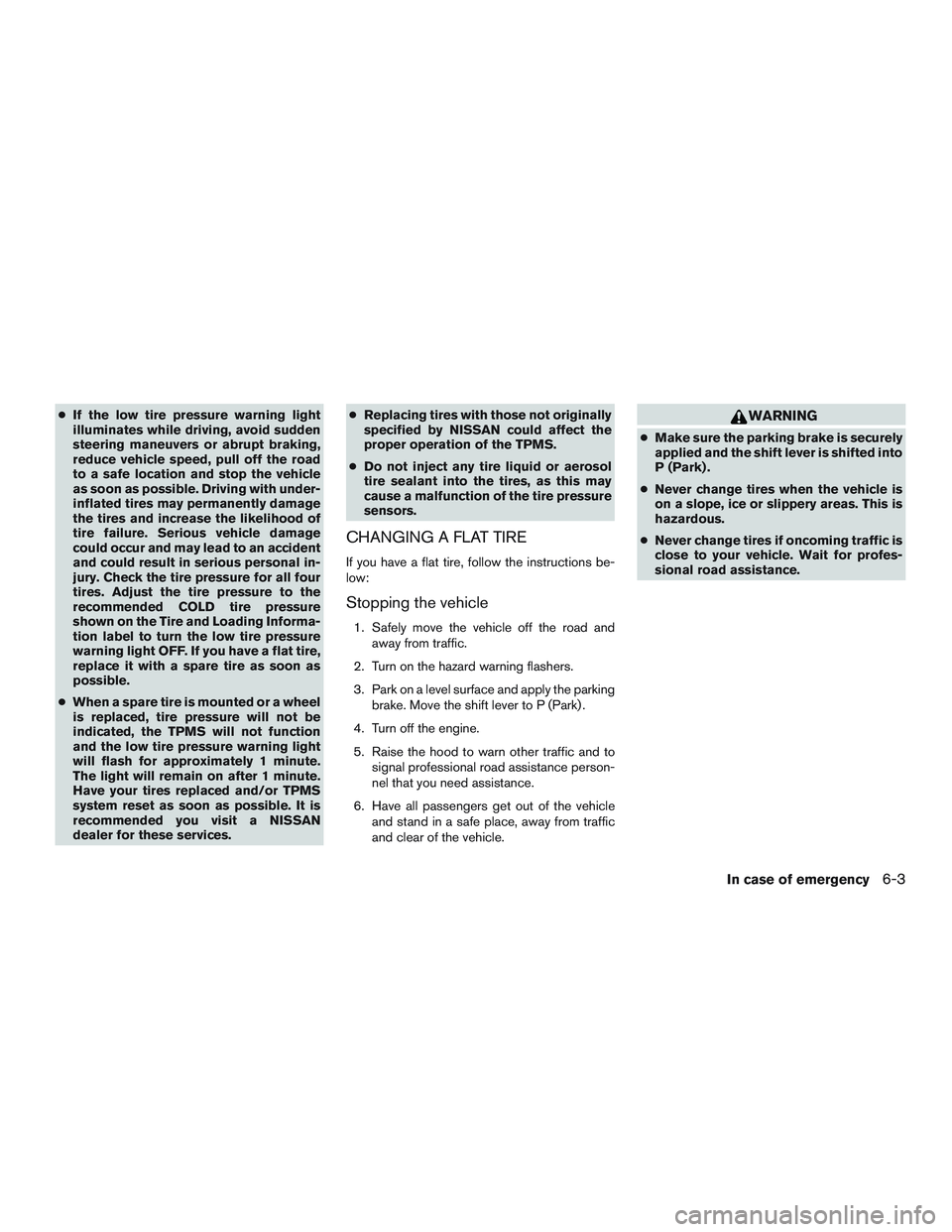
●If the low tire pressure warning light
illuminates while driving, avoid sudden
steering maneuvers or abrupt braking,
reduce vehicle speed, pull off the road
to a safe location and stop the vehicle
as soon as possible. Driving with under-
inflated tires may permanently damage
the tires and increase the likelihood of
tire failure. Serious vehicle damage
could occur and may lead to an accident
and could result in serious personal in-
jury. Check the tire pressure for all four
tires. Adjust the tire pressure to the
recommended COLD tire pressure
shown on the Tire and Loading Informa-
tion label to turn the low tire pressure
warning light OFF. If you have a flat tire,
replace it with a spare tire as soon as
possible.
● When a spare tire is mounted or a wheel
is replaced, tire pressure will not be
indicated, the TPMS will not function
and the low tire pressure warning light
will flash for approximately 1 minute.
The light will remain on after 1 minute.
Have your tires replaced and/or TPMS
system reset as soon as possible. It is
recommended you visit a NISSAN
dealer for these services. ●
Replacing tires with those not originally
specified by NISSAN could affect the
proper operation of the TPMS.
● Do not inject any tire liquid or aerosol
tire sealant into the tires, as this may
cause a malfunction of the tire pressure
sensors.
CHANGING A FLAT TIRE
If you have a flat tire, follow the instructions be-
low:
Stopping the vehicle
1. Safely move the vehicle off the road and
away from traffic.
2. Turn on the hazard warning flashers.
3. Park on a level surface and apply the parking brake. Move the shift lever to P (Park) .
4. Turn off the engine.
5. Raise the hood to warn other traffic and to signal professional road assistance person-
nel that you need assistance.
6. Have all passengers get out of the vehicle and stand in a safe place, away from traffic
and clear of the vehicle.
Page 453 of 510
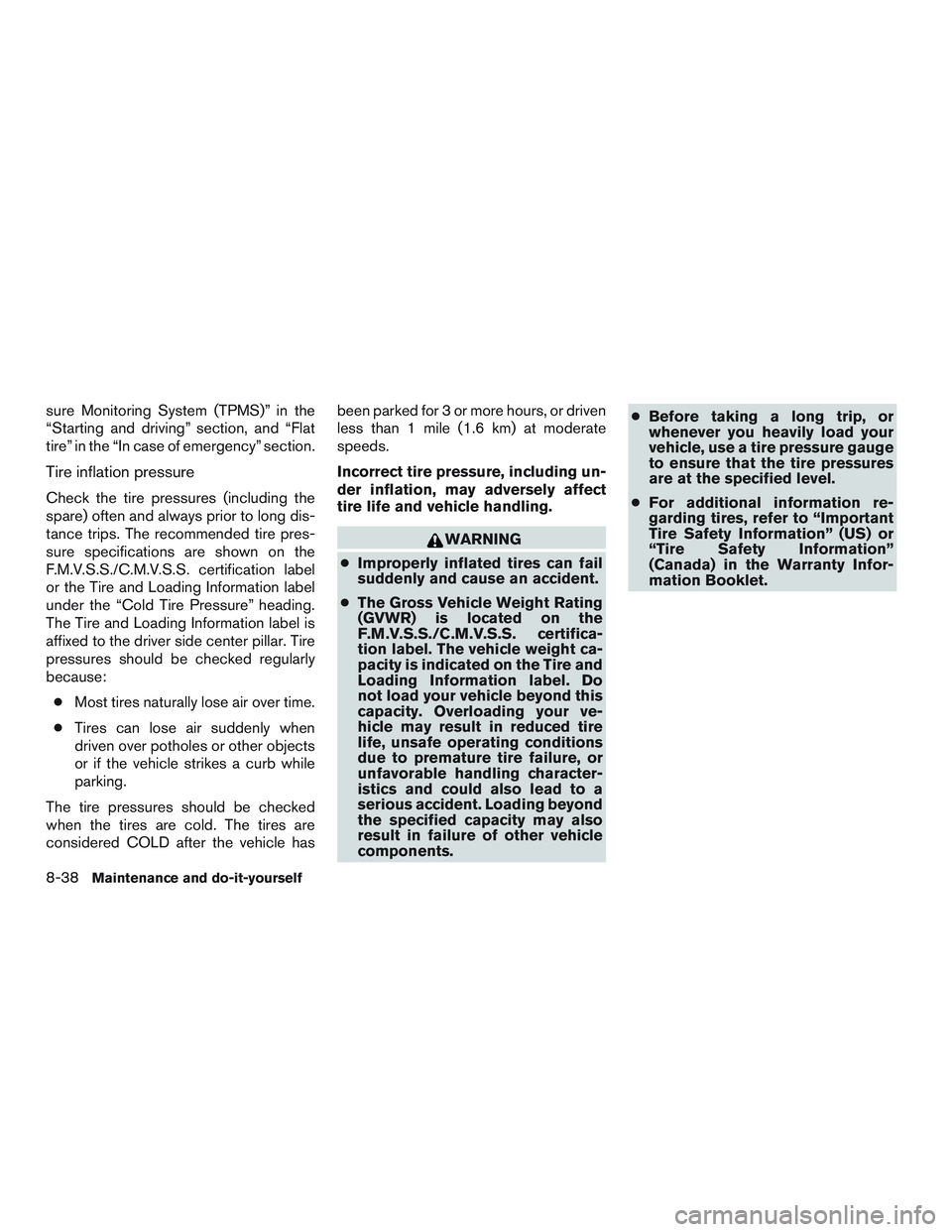
sure Monitoring System (TPMS)” in the
“Starting and driving” section, and “Flat
tire” in the “In case of emergency” section.
Tire inflation pressure
Check the tire pressures (including the
spare) often and always prior to long dis-
tance trips. The recommended tire pres-
sure specifications are shown on the
F.M.V.S.S./C.M.V.S.S. certification label
or the Tire and Loading Information label
under the “Cold Tire Pressure” heading.
The Tire and Loading Information label is
affixed to the driver side center pillar. Tire
pressures should be checked regularly
because:● Most tires naturally lose air over time.
● Tires can lose air suddenly when
driven over potholes or other objects
or if the vehicle strikes a curb while
parking.
The tire pressures should be checked
when the tires are cold. The tires are
considered COLD after the vehicle has been parked for 3 or more hours, or driven
less than 1 mile (1.6 km) at moderate
speeds.
Incorrect tire pressure, including un-
der inflation, may adversely affect
tire life and vehicle handling.
Page 506 of 510
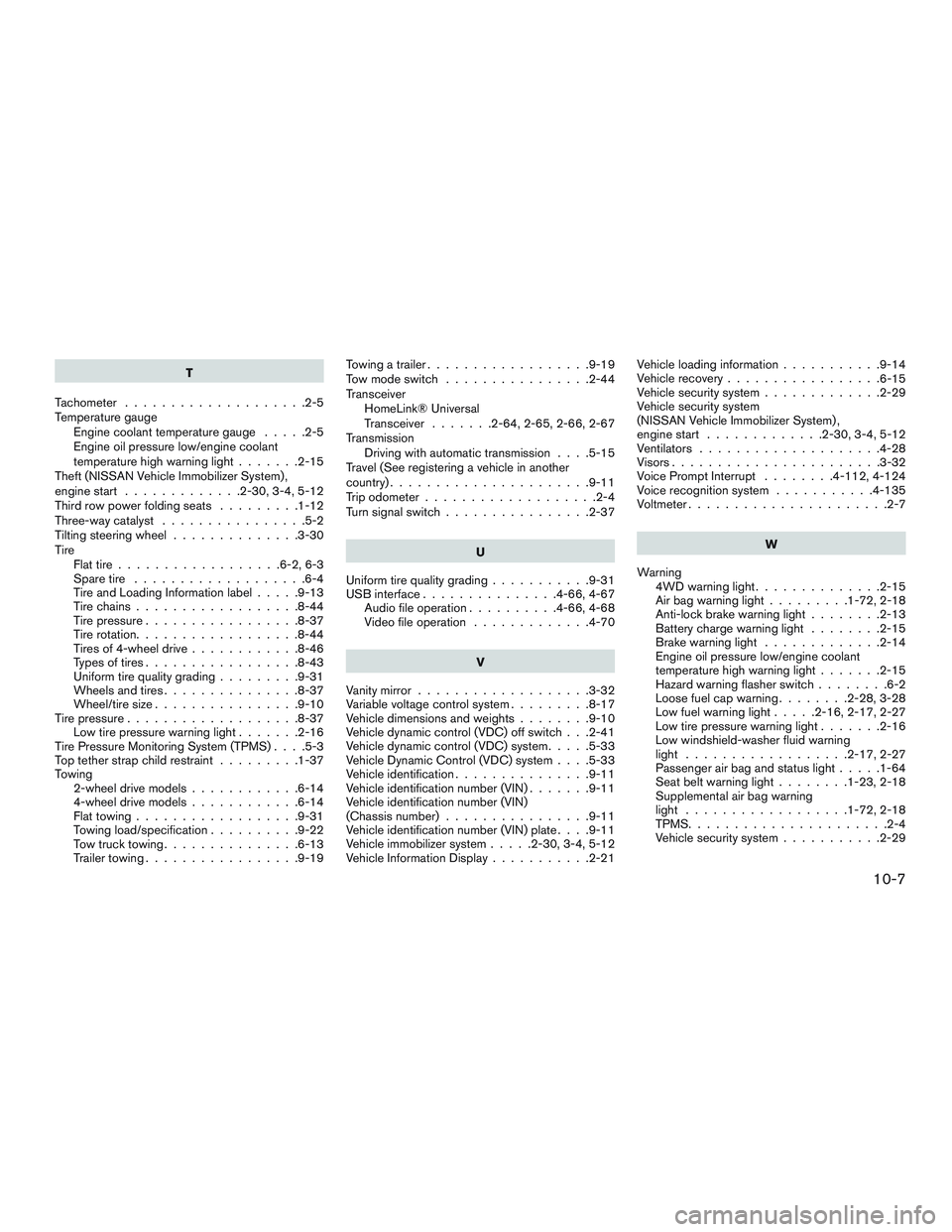
T
Tachometer ....................2-5
Temperature gauge Engine coolant temperature gauge .....2-5
Engine oil pressure low/engine coolant
temperature high warning light .......2-15
Theft (NISSAN Vehicle Immobilizer System) ,
engine start .............2-30,3-4,5-12
Third row power folding seats .........1-12
Three-way catalyst ................5-2
Tilting steering wheel ..............3-30
Tire Flat tire ..................6-2,6-3
Spare tire ...................6-4
TireandLoadingInformationlabel.....9-13
Tire chains ..................8-44
Tirepressure.................8-37
Tire rotation..................8-44
Tires of 4-wheel drive ............8-46
Types of tires .................8-43
Uniform tire quality grading .........9-31
Wheels and tires ...............8-37
Wheel/tire size ................9-10
Tirepressure...................8-37 Low tire pressure warning light .......2-16
Tire Pressure Monitoring System (TPMS) ....5-3
Top tether strap child restraint .........1-37
Towing 2-wheel drive models ............6-14
4-wheel drive models ............6-14
Flattowing..................9-31
Towing load/specification ..........9-22
Towtrucktowing...............6-13
Trailer towing .................9-19 Towing a trailer
..................9-19
Tow mode switch ................2-44
Transceiver HomeLink® Universal
Transceiver .......2-64,2-65,2-66,2-67
Transmission Driving with automatic transmission ....5-15
Travel (See registering a vehicle in another
country) ......................9-11
Trip odometer ...................2-4
Turn signal switch ................2-37
U
Uniform tire quality grading ...........9-31
USB interface ...............4-66,4-67
Audio file operation ..........4-66,4-68
Video file operation .............4-70
V
Vanity mirror ...................3-32
Variable voltage control system .........8-17
Vehicle dimensions and weights ........9-10
Vehicle dynamic control (VDC) off switch . . .2-41
Vehicle dynamic control (VDC) system .....5-33
Vehicle Dynamic Control (VDC) system ....5-33
Vehicle identification ...............9-11
Vehicle identification number (VIN) .......9-11
Vehicle identification number (VIN)
(Chassis number) ................9-11
Vehicle identification number (VIN) plate ....9-11
Vehicle immobilizer system .....2-30,3-4,5-12
Vehicle Information Display ...........2-21Vehicle loading information
...........9-14
Vehicle recovery ................. 6-15
Vehicle security system .............2-29
Vehicle security system
(NISSAN Vehicle Immobilizer System) ,
enginestart .............2-30,3-4,5-12
Ventilators ....................4-28
Visors.......................3-32
Voice Prompt Interrupt ........4-112, 4-124
Voice recognition system ...........4-135
Voltmeter......................2-7
W
Warning 4WD warning light ..............2-15
Airbagwarninglight.........1-72,2-18
Anti-lock brake warning light ........2-13
Battery charge warning light ........2-15
Brake warning light .............2-14
Engine oil pressure low/engine coolant
temperature high warning light .......2-15
Hazard warning flasher switch ........6-2
Loose fuel cap warning ........2-28,3-28
Low fuel warning light .....2-16,2-17,2-27
Low tire pressure warning light .......2-16
Low windshield-washer fluid warning
light ..................2-17,2-27
Passenger air bag and status light .....1-64
Seat belt warning light ........1-23,2-18
Supplemental air bag warning
light ..................1-72,2-18
TPMS ......................2-4
Vehicle security system ...........2-29
10-7